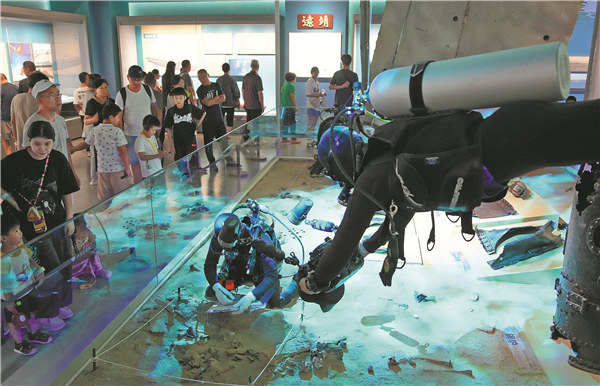

Wrecks from naval battles provide a new understanding of historic events, report Zhao Ruixue in Jinan and Wang Kaihao in Beijing.
As Jiang Bo, an esteemed maritime archaeologist, stood before a photo of a large section of a battleship being raised from the sea, he was in a thoughtful mood.
Coincidentally or not, on Sept 17,2020, the anniversary of the Battle of the Yalu River (also known as Battle of the Yellow Sea) — a major naval engagement during the Sino-Japanese War (1894-95) — Jiang and his colleagues brought ashore an 18.7-metric-ton component of the Dingyuan, the ironclad flagship of the Beiyang Fleet during the Qing Dynasty (1644-1911).
"In the enigmatic depths, there always exists a connection," Jiang, director of Maritime Archaeological Research Center of Shandong University, mused while gazing at the photo.
Bear in Mind the History: The Exhibition of the Sino-Japanese Naval War and Underwater Archaeological Findings From the Sunken Warships, an exhibition at the Shandong Museum in Jinan, Shandong province, has put around 330 artifacts excavated from sunken warships on display, and offers visitors deep insight into history, as well as the poignant legacy of the war on its 130th anniversary.
The Beiyang Fleet was China's first modern navy and grew out of the determination of the Qing government to defend national security. From 1875 until the outbreak of the Sino-Japanese War, the government ordered 46 advanced warships from the United Kingdom and Germany, and also built vessels of their own.
Despite this, the Battle of the Yalu River, which took place off the coast of Liaoning province, remains a painful collective memory for generations of Chinese. Five ships were sunk during the fierce battle, at a cost of hundreds of lives.
The Battle of Weihaiwei, off the coast of Weihai in Shandong province, the following year led to another major defeat and annihilation of the fleet, ending the dynasty's dream of turning its destiny around.
Remnants of this history lay deep underwater for over a century. Following the maiden voyage of the country's first vessel designed for underwater research in 2014, Jiang and fellow archaeologists launched a project to find physical evidence of the fleet.